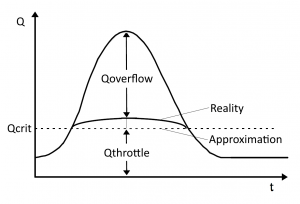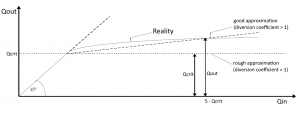Verzweigung/en: Unterschied zwischen den Versionen
Keine Bearbeitungszusammenfassung |
Keine Bearbeitungszusammenfassung |
||
| Zeile 13: | Zeile 13: | ||
==Threshold Value (Option 1)== | ==Threshold Value (Option 1)== | ||
[[Datei:Abflussaufteilung_nach_Schwellwertkonzept_EN.png|thumb|Discharge distribution using a threshold value]] | |||
[[ | In this case the second outflow only becomes active if the inflow exceeds the threshold of <code>Qcrit</code>. In the threshold value approach, the 2nd outlet (e.g. stormwater overflow) is only activated once a critical inflow <code>Qcrit</code> is exceeded, causing the throttled outflow to back up, reaching the overflow threshold. Since in reality a perfect division of the outflows after reaching the threshold value is usually never achieved, a diversion coefficient can also be specified in order to better represent actual conditions. | ||
[[ | [[Datei:Trennschärfe_EN.png|thumb|Definition of the diversion coefficient in Talsim-NG]] | ||
It is defined as: <math>\mbox{ | It is defined as: <math>\mbox{diversion coefficient}= \frac{Q_{in}(Q_{out}=5 \cdot Q_{crit})}{Q_{crit}}</math> | ||
Version vom 26. November 2020, 10:37 Uhr
Diversions are used to divide an inflow into two outflows according to a distribution rule. This can be used to model structures that withdraw water from rivers for water supply or irrigation purposes, branches in canals, diversions at the inlet or outlet of reservoirs, stormwater overflows, etc.
Three approaches are possible for defining the distribution rule.
Threshold Value (Option 1)
In this case the second outflow only becomes active if the inflow exceeds the threshold of Qcrit. In the threshold value approach, the 2nd outlet (e.g. stormwater overflow) is only activated once a critical inflow Qcrit is exceeded, causing the throttled outflow to back up, reaching the overflow threshold. Since in reality a perfect division of the outflows after reaching the threshold value is usually never achieved, a diversion coefficient can also be specified in order to better represent actual conditions.
It is defined as: [math]\displaystyle{ \mbox{diversion coefficient}= \frac{Q_{in}(Q_{out}=5 \cdot Q_{crit})}{Q_{crit}} }[/math]
Percentage distribution (option 2)
Regardless of the inflow, a constant division into two sequences Qab1 and Qab2 is made according to a certain percentage ratio. Also here, it is possible to change the division through scaling.
Characteristic Curve (option 3)
A dependency between the discharge Qab1 and the inflow resulting from hydraulic calculations or from operating regulations is used as a polygon course. The second drain Qab2 is determined as the residual value between inflow - Qab1.


